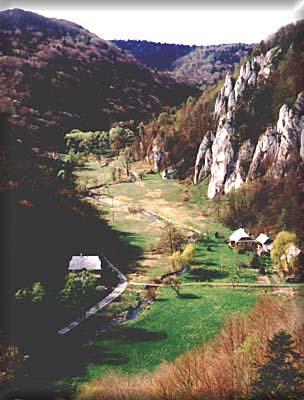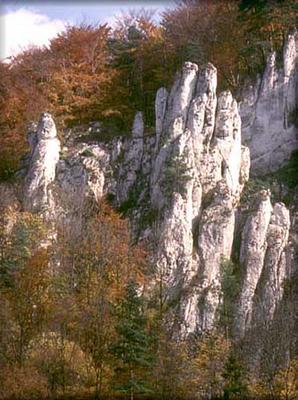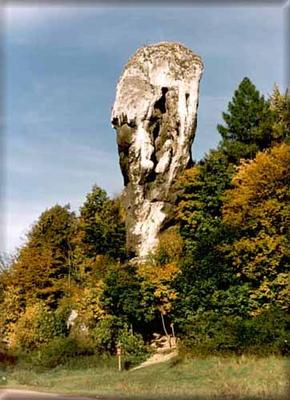Results of some research and not only
Hi again:) Today I would like to present to you a stuff that is somewhat different to the one I have described till now. Namely I am going to present to you an abstract(=summary) done on a basis of one particular flora-research carried out in a region marked as a violet rectengular on a map beneath. Who did the research? A man whose name I cannot give to you. Why did he carry this research out? Because he wanted to be higher in Polish academic hierarchy. Why am I writing about his research right now? Firstly because the territory it was done on is almost neighbouring to a Landscape Park “Forests upon Upper Liswarta river” (brown circle on the left of violet rectangular on the map beneath) where I have done my research and for the second I am putting this bigger part of the abstract in this entry of mine cause all in all it seems immposible to me both people could type such long textes when no computers they had at all (however these are times seem to me to be more human all in all cause they tried at least to be more polite and kind in their daily routine towards one another) and what is much more worthy to remember as it seems to me today Silesia used to be an industrial power of Poland not so long ago while today only industrial ruins we have everywhere here. Well, on the right of violet rectangular that represents the central part of Cracow-Wieluń Upland, on the map I have added below you can also see Ojcowski National Park (on the map a town Ojców is marked) 16 kilometres far from the city Crakow (not marked on the map beneath). I will write more about this smallest Polish National Park soon. Today I would like only to state that all pictures in this entry (apart from the map) come from Ojcowski National Park. I hope both you enjoy looking at them and can find some interesting informations reading the abstract beneath:

AN ABSTRACT
Geobotanical problems of the central part of he Cracow-Wieluń Upland.
The elaboration is a monography treating of the geobotanical conditions prevailing in the central part of Cracow-Wieluń Upland, a region remaining under the strong pressure of the pollutants emitted by the Upper-Silesian Industrial Region as well as of the multiple and local anthropogenic actions, eg. open mining, agriculture, chemization and land meliorations. It represents a recapitulation of the author’s 12 years investigations (carried out in the years 1972-1984) as well as of the findings of other researchers’ work made during the last hundred years. It involves a complete analysis of vascular plants flora (1125 species including 885 native, 317 adventitious and 23 hybrids) and presents a short survey of natural, seminatural and synanthropic plant communities (149 assosiations, 28 communities with indetermined as yet synataxonic unit) within the most important biotopes i.e. forests, bushes, xerothermic and pssammophilous vegetation, meadows and pastures, cottage-side places, cultivated fields and boundary strips, sewerages and stagnant waters like kilns, gravel pits, clay pits, sand pits, railway tracks and stations, border communities
The work attracts particular attention to the following questions:
- decay of the plant species
- degeneration of natural, seminatural phytocenosis and origin of xenospontaneus communities
- migration of adventitious species
- geobotanical differentiantion of the territory
In the light of contemporary investigation he balance of the losses in the flora living at the territory under investigation comes to 5 percent. In the relation to 66 disapeared species the highest losses were noticed among the elements of the native flora (82 percent), mainly xerothermic grasses and bushes (33 percent), peat land and meadows of different types (21 percent) , deciduous forest (17 percent).
The process of antropopressure, intensifying in the last decade is at the territory under examination advanced to the different extent, that is why one can distuinguish regions with the dominance of the landscape natural or cultural or even devastated. The forests of this region are in the first, second or third zone of pollution. The influence of toxic gases manifests itself in the fall out of fir from the beech stands , decay of the conifers vitality (pine and spruce), necroses origin and early yellowing of the deciduous trees leaves. Meadows are endangered with extensive drying of platy and grassland vegetation –destroying by the extensive tourism movement (…). The elaboration treats in detail of the questions involving the nature protection, i.e.alternative measures undertaken to protect these species and communities that show tendency to disappear; preservation and extermination of the plants under protection; project of the rational network of nature reservates. Besides the author makes an attempt at graphical representing the extent of vegetation synanthropization process taking place the territory under examination.







Komentarze (0):
Prześlij komentarz
Subskrybuj Komentarze do posta [Atom]
<< Strona główna